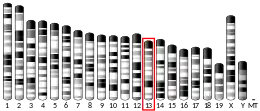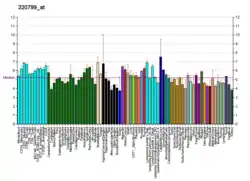GCM2
Chorion-specific transcription factor GCMb is a protein that in humans is encoded by the GCM2 gene.[5][6]
The Drosophila 'glial cells missing' (gcm) gene is thought to act as a binary switch between neuronal and glial cell determination. The gcm protein and mammalian gcm homologs contain a conserved N-terminal gcm motif that has DNA-binding activity. See GCM1 (MIM 603715).[supplied by OMIM][6]
References
- GRCh38: Ensembl release 89: ENSG00000124827 - Ensembl, May 2017
- GRCm38: Ensembl release 89: ENSMUSG00000021362 - Ensembl, May 2017
- "Human PubMed Reference:". National Center for Biotechnology Information, U.S. National Library of Medicine.
- "Mouse PubMed Reference:". National Center for Biotechnology Information, U.S. National Library of Medicine.
- Kanemura Y, Hiraga S, Arita N, Ohnishi T, Izumoto S, Mori K, Matsumura H, Yamasaki M, Fushiki S, Yoshimine T (Feb 1999). "Isolation and expression analysis of a novel human homologue of the Drosophila glial cells missing (gcm) gene". FEBS Lett. 442 (2–3): 151–6. doi:10.1016/S0014-5793(98)01650-0. PMID 9928992. S2CID 2469563.
- "Entrez Gene: GCM2 glial cells missing homolog 2 (Drosophila)".
Further reading
- Kammerer M, Pirola B, Giglio S, Giangrande A (1999). "GCMB, a second human homolog of the fly glide/gcm gene". Cytogenet. Cell Genet. 84 (1–2): 43–7. doi:10.1159/000015210. PMID 10343099. S2CID 23760189.
- Correa P, Akerström G, Westin G (2002). "Underexpression of Gcm2, a master regulatory gene of parathyroid gland development, in adenomas of primary hyperparathyroidism". Clin. Endocrinol. 57 (4): 501–5. doi:10.1046/j.1365-2265.2002.01627.x. PMID 12354132. S2CID 2137270.
- Strausberg RL, Feingold EA, Grouse LH, et al. (2003). "Generation and initial analysis of more than 15,000 full-length human and mouse cDNA sequences". Proc. Natl. Acad. Sci. U.S.A. 99 (26): 16899–903. Bibcode:2002PNAS...9916899M. doi:10.1073/pnas.242603899. PMC 139241. PMID 12477932.
- Mungall AJ, Palmer SA, Sims SK, et al. (2003). "The DNA sequence and analysis of human chromosome 6". Nature. 425 (6960): 805–11. Bibcode:2003Natur.425..805M. doi:10.1038/nature02055. PMID 14574404.
- Maret A, Bourdeau I, Ding C, et al. (2004). "Expression of GCMB by intrathymic parathyroid hormone-secreting adenomas indicates their parathyroid cell origin". J. Clin. Endocrinol. Metab. 89 (1): 8–12. doi:10.1210/jc.2003-030733. PMID 14715818.
- Gerhard DS, Wagner L, Feingold EA, et al. (2004). "The Status, Quality, and Expansion of the NIH Full-Length cDNA Project: The Mammalian Gene Collection (MGC)". Genome Res. 14 (10B): 2121–7. doi:10.1101/gr.2596504. PMC 528928. PMID 15489334.
- Kebebew E, Peng M, Wong MG, et al. (2005). "GCMB gene, a master regulator of parathyroid gland development, expression, and regulation in hyperparathyroidism". Surgery. 136 (6): 1261–6. doi:10.1016/j.surg.2004.06.056. PMID 15657585.
- Thomée C, Schubert SW, Parma J, et al. (2005). "GCMB mutation in familial isolated hypoparathyroidism with residual secretion of parathyroid hormone". J. Clin. Endocrinol. Metab. 90 (5): 2487–92. doi:10.1210/jc.2004-2450. PMID 15728199.
- Baumber L, Tufarelli C, Patel S, et al. (2006). "Identification of a novel mutation disrupting the DNA binding activity of GCM2 in autosomal recessive familial isolated hypoparathyroidism". J. Med. Genet. 42 (5): 443–8. doi:10.1136/jmg.2004.026898. PMC 1736051. PMID 15863676.
This article is issued from Wikipedia. The text is licensed under Creative Commons - Attribution - Sharealike. Additional terms may apply for the media files.




